Explore innovative supply chain analytics
With 2021 ending, it's time to get out the crystal ball and make some predictions for the year ahead. The last two years have been a steep learning...
4 min read
Katrina Youdale : Sep 27, 2022

An organization is defined by its income and expenses. After all, business success stems from the efficient management of outflow and inflow across their supply chain.
However simple this fact appears in writing, it is a lot more complicated in practice. Each business exists in a fragile ecosystem that is vulnerable to global events, consumer trends, regulation changes and environmental risks, among many, many other challenges.
AI driven supply chain analytics empowers companies to take a proactive approach when navigating with this intricate ecosystem.
supply chain analytics , also known and spend analytics, refers to the process of identifying, collecting, cleansing, categorizing, and analyzing a company’s spend data. The main benefits of spend analysis in procurement include accurately identifying patterns in addition to gaining greater spend visibility.
The information generated from spend analytics is used by organizations to make proactive, informed decisions to decrease procurement costs and improve efficiencies.
Big data and AI supply chain analytics is a valuable tool for companies looking to streamline their procurement management processes by enhancing key spend analytics benefits. To put it simply, big data allows organizations to accurately examine broader trends and spending patterns within large amounts of data.
The role of big data analytics is widespread when it comes to spend analysis and securing a higher ROI. How an organization implements its analysis into big data procurement will ultimately come down to its industry, size, and internal capabilities.
Five of the most notable areas where big data analytics can be employed to great success are:
Data gathering is a key component of the entire spend analytics process pipeline. AI driven supply chain analytics involves gathering historic spend data from a wide range of sources, and consolidating the information so that it is accessible from one central location.
In order to ensure that the data is accurate and meaningful, data analysts must cleanse the collected data by detecting and fixing any records that are duplicated, corrupt, irrelevant, or incorrect.
AI-driven data analytics can be used to automatically categorize, organize and store data for future use. Spend data categorization also helps companies pinpoint trends and use the identified variables to conduct predictive analytics.
The above processes support the various components of spend data analysis by providing a reliable, data-driven knowledge base for:
Spend data visualization describes the process of converting raw data into a visual context, whether that be through a graph, chart, or interactive dashboard. Visualization is a critical part of the data analysis process as it transforms large sets of data into a user-friendly format that clearly showcases patterns and outliers.
Humans respond to visual information in a much more emotive way than words or numbers, making data visualization an especially powerful tool for communicating with key stakeholders across any organization.
The ROI of AI driven supply chain analytics in procurement will depend on the business model it is applied to and their individual preferences. As savings scale with spending, spend analytics is most economical when used by businesses with high spending, typically exceeding $1 billion. Agile companies tend to secure a higher benefit from spend analytics as they can swiftly adapt to real-time information to deliver greater value.
Of course, investing in spend analytics doesn’t necessitate an ‘all or nothing’ mindset. Specific areas of concern may require spend analytics, while others may not. Organizations can scale their efforts to strike a perfect balance between supporting business goals and investing economically in spend analytics.
Before investing in AI and big data procurement and supply chain analytics, it is recommended that organizations create KPIs to measure the value of their spend analytics. This will allow them to monitor their savings and assess their procurement function’s ability to interpret collected data.
Spend analysis is a time-consuming process that can easily become overwhelming when maintained through paper management.
AI big data tools can work together with data analysts to improve speed and enhance the granularity of the collected data. These AI-driven big data platforms provide companies with deeper insights into internal and external events. This can in turn empower companies to purposefully channel their resources into more productive pursuits that actively improve working capital performance.
When used effectively, AI-driven data tools can:
Access to AI-driven data tools allows companies to spend less time and fewer resources on low-value number crunching. Instead, the capability of employees can be dedicated to conducting high value strategic analysis.
AI-driven data tools are particularly useful for optimizing the allocation of time and resources. By appreciating where and how resources are used, companies can direct available resources to the areas which they will be most constructive.
Companies can further capitalize on the insights generated by AI-driven data tools by identifying opportunities where costs could reasonably be cut without negatively impacting other areas of business.
Being able to predict supply chain risks provides companies with the ability to pre-emptively take concerted action to eliminate or reduce risks. Predictive analysis is also valuable for gaining a competitive advantage in the marketplace.
It is difficult to build productive and meaningful solutions to issues without first understanding the root cause of the problem. By using data-driven insights from delivery cycles, companies can recognize areas that are weakened by inefficiencies and build meaningful, targeted solutions that will increase customer satisfaction.
One of the main benefits of AI-powered big data tools is that they can monitor both internal and external contexts. This means that companies can utilize their big data tools to keep an eye on key performance metrics across business functions and then capitalize on this enhanced insight to identify opportunities for improvement.
Capturing meaningful data doesn’t have to come at the cost of time, money, or resources.
RobobAI gives companies access to a global procurement knowledge base, empowering them to make smart and informed business decisions supported by real-time data. Request a Demo today and discover how RobobAI's innovative AI-powered spend analytics can help your organization optimize its functions.

With 2021 ending, it's time to get out the crystal ball and make some predictions for the year ahead. The last two years have been a steep learning...

In the wake of the COVID-19 pandemic, a significant shift is occurring in global manufacturing and supply chain operations.

As global supply chains continue to grow in size and complexity, managing these networks can often be complicated by disparate data sources and...